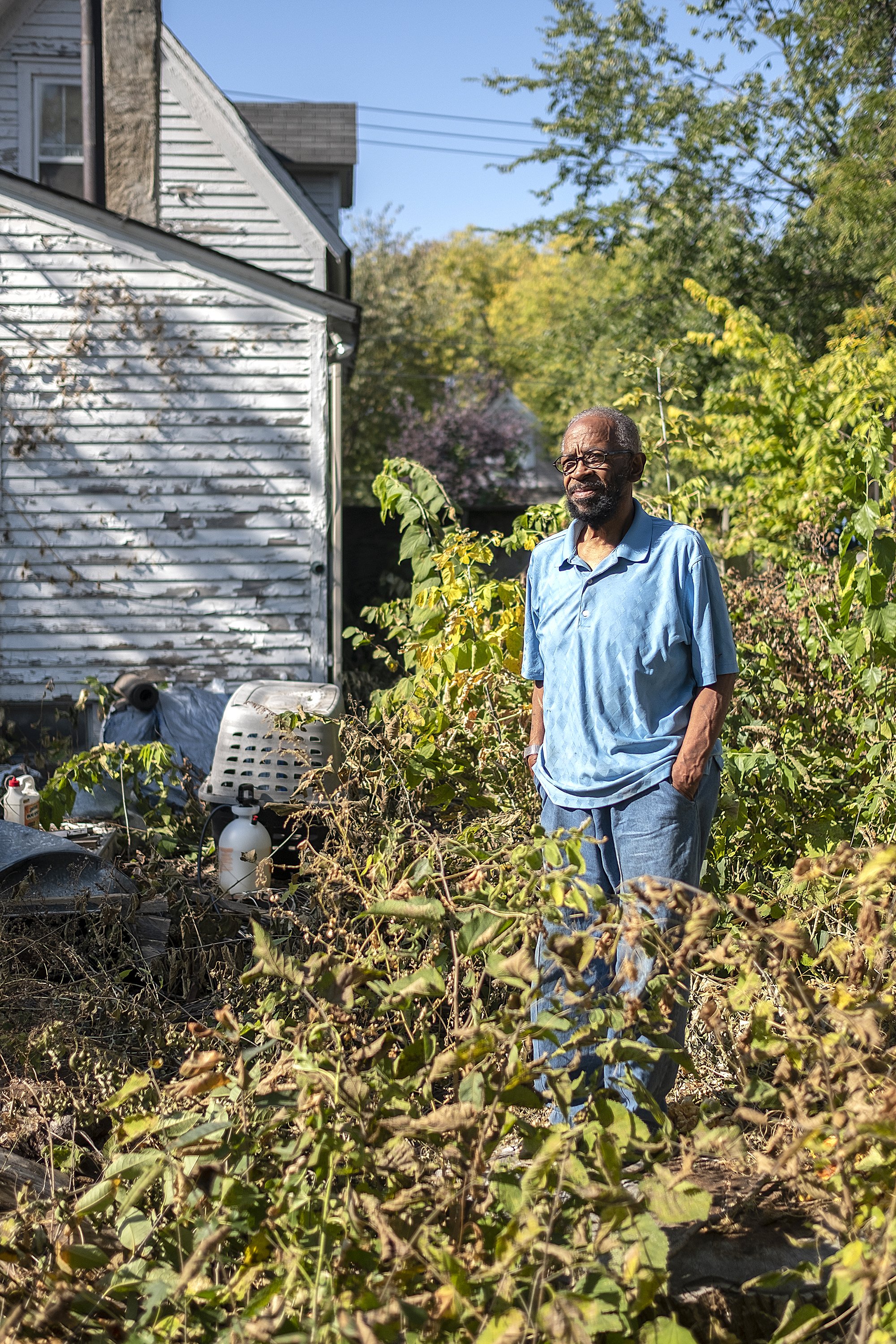Emerald Ash Borer is devastating Northside trees and residents on fixed incomes
Sharon Griffin rests on what remains of an ash tree that was cut down by order of the Minneapolis Parks and Recreation Board. Her neighborhood association helped her pay for the removal. Photo by David Pierini
By David Pierini, Editor
Winston Minor has a hole in his roof, a few broken windows and is behind on his taxes. Homeownership on a monthly social security check was already hard enough when the city’s parks department hired a tree service to remove a gigantic ash tree, ravaged by Emerald Ash Borer, from the backyard of his Harrison home.
All that remains for Minor, 74, is a stump and a bill for $6,000.
“It’s like trying to live on a 10-cent budget but you only have one cent,” Minor said. “I can’t do too much, I try to pay the bills, I try to eat, I try to live, I try to repair the house. That’s life though.”
Emerald Ash Borer was first detected in Minneapolis 2010 and its spread is now biting into the tree canopy of North Minneapolis, according to the Minneapolis Parks and Recreation Board. (MPRB) has legal authority to mandate tree removal, especially once those trees are overtaken by an invasive pest that has killed tens of millions of trees through the eastern half of the United States.
MPRB’s tree inspectors this year have marked 940 trees for removal, with more than half on the Northside, according MPRB records. Tree inspectors found 246 in zip code 55411 and 229 in 55412, records show.
Preserving the urban forest is critical to the environment but to residents living with some of the lowest median incomes in the state, tree removal is just another bill they can not pay.
The most common recourse for a property owner on a fixed income is having the cost of tree removal added to their tax bill spread out over a five- or 10-year period. That includes interest.
MPRB is planning public hearings to explore additional ways to defray costs. Mid-Minnesota Legal Aid and the Harrison Neighborhood Association are working with MPRB to find financial assistance options for people like Minor.
“It’s a little hard to chew,” said MPRB Commissioner Becka Thompson, who represents the Northside. “I have nothing against the process because there is a legitimate need for these trees to be removed, but there’s a lot of homeowners who are retired and are living on slashed fixed incomes who are needing some form of assistance.
“I am not a forestry expert and I’m not going to claim to be, but can’t we just wait a couple of years? With our economy, the inflation we’re facing and the massive property tax increases... Those are real. Can we just let this pass?”
Arborists are likely to say no.
A section of ash tree shows the tunnels dug by the larvae. The tree dies because the larvae eat a layer of the tree that transports water and nutrients. Photo by David Pierini
On the move
Emerald Ash Borer is native to northwest Asia but likely arrived in the U.S. on infected wood used in shipping materials, according to the National Park Service. It was first discovered in the U.S. in 2002. The first point of infestation in Minneapolis was in a southeast neighborhood park.
No state in the U.S. has more ash trees than Minnesota, according to the DNR, and with roughly 200,000 ash trees in Minneapolis alone, MPRB has worked to pre-empt the spread by taking down ash trees on boulevards and in parks.
Residents have grown to understand a painted green ring around an ash tree marks it for removal.
The luminous green beetle burrows into the bark to lay eggs and the larvae tunnel through and eat an inner skin of the tree that transports water and nutrients to its branches.
A tree service can inject a healthy tree with an insecticide that kills the larvae, but unprotected trees, even those 50- to 80- feet tall, can die within two to four years.
NPS biologists say the beetle spreads about a mile each year, which makes removing the dying ash trees the best way to prevent or at least slow the ash borers’ advance.
“There’s a threshold where basically after a third of the tree dies back, it’s unlikely anything will work to prevent further spread and ultimate decline,” Jeremy Barrick, assistant superintendent of environmental stewardship, said at a Sept. 28 parks board meeting. “Emerald Ash Borer... is impacting the Northside this year at a higher level than other parts of the city as infestation has moved through our city, east to west and north to south. In previous years, it was in other parts of the city.”
Barrick said ash trees were considered affordable and fast-growing when arborists planted them to replace elm trees which had been wiped out by Dutch Elm disease. Arborists now see that planting mostly ash was a mistake when the science now suggests urban forests are healthier with a variety of trees, he said.
Cutting costs
Winston Minor stands where a large ash tree once stood. Now he is left with a bill that gets tacked on to his property taxes. Photo by David Pierini
The cost of removing a sizable ash tree often starts around $2,000. The price varies based on height, diameter and location. Backyard trees can be particularly challenging because of power lines and narrow alleys to maneuver equipment like a crane and stump grinder.
One Harrison resident received a notice from MPRB listing quotes from four different services. The cheapest was $4,000 and the most expensive was for more than $15,000. High quotes generally come from services who have to rent the type of equipment some larger services already own.
Mitchel Hansen, the community outreach director for the Harrison Neighborhood Association, said his organization has been trying to help its residents since notices began going out this past spring. The organization has used about $6,000 of a $10,000 home improvement fund to help residents pay for tree removal.
Hanson said multiple forces, especially development, are already pricing people out of their homes in Harrison.
“There’s potential for a program like this to displace people,” Hanson said. “Let's talk about the 60 percent increase in property taxes over the past few years and the effect that this has had. When factoring in the Mayor’s proposed 12 percent increase over the next two years, in addition to tree removals, we are in the middle of a serious crisis with many layers.”
Minnesota law makes people responsible for the trees on the land they own. Management for local trees falls to municipalities and in Minneapolis, this responsibility falls to MPRB.
Residents are notified of an infected tree on their property and given a deadline. They can hire their own tree service or MPRB will hire a service and bill the resident.
“I have nothing against the process because
there is a legitimate need for these trees to be removed, but there’s a lot of homeowners who are retired and are living on slashed fixed incomes who are needing some form of assistance.”
MPRB offers two levy assessment options of five- and 10-years for property owners claiming hardship. It will also waive the $80 administrative fee with either option.
Hanson worries a lien on Minor’s property further jeopardizes a man already behind on taxes. The neighborhood association is working with Minor in hopes of paying off the tree bill.
Sharon Griffin was able to get a grant for $4,000 from the neighborhood association to cover her tree removal. Griffin’s tree is down but it still rests in her side yard. A neighborhood tree enthusiast stopped by Griffin's recently to count the rings on the stump. He guessed
the tree was first planted in 1932.
“I didn’t worry about it because I don’t have the money,” said Griffin, 66, whose only income is social security. “You can do all these things, keep sending me notices and you still can’t get it.” She was grateful for Hanson’s help, saying, “He was on the
move for me.”
MPRB voted on Sept. 28 to hold public
hearings to hear concerns of distressed property owners and determine if it can do more to help them. A hearing date has not been set.
Thompson, in her first year as a parks board member, isn’t sure what actions she and her colleagues can take to bring relief to hardship cases.
“This is where being a rookie politician is a bit of a disadvantage,” Thompson said. “I don’t have all the answers but I’m trying to figure out what we can do in the larger scope. I’m not alone on this. There are a lot of people in the department and on the board who are empathetic to what’s happening on the Northside. They want to make it right.”



